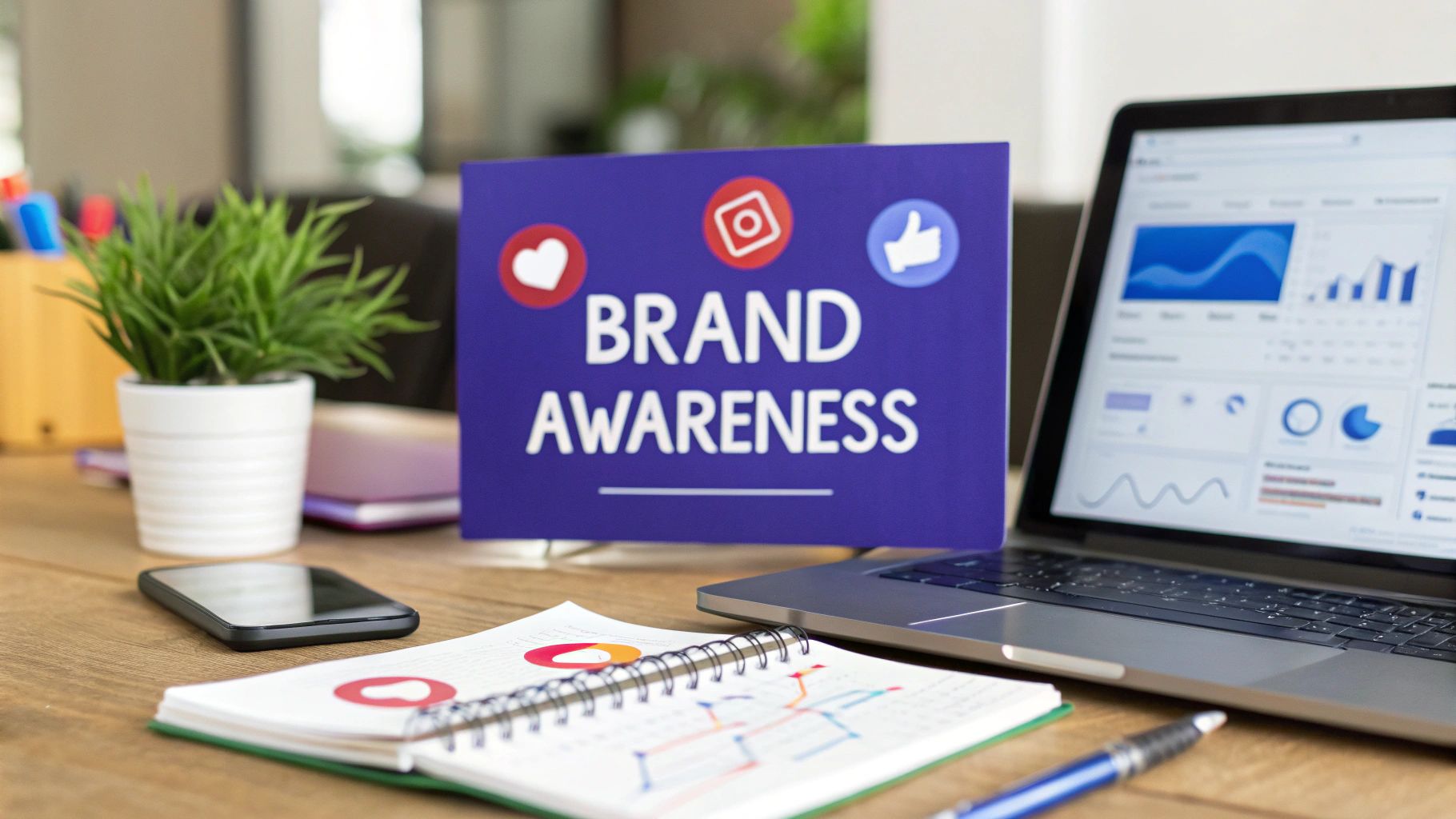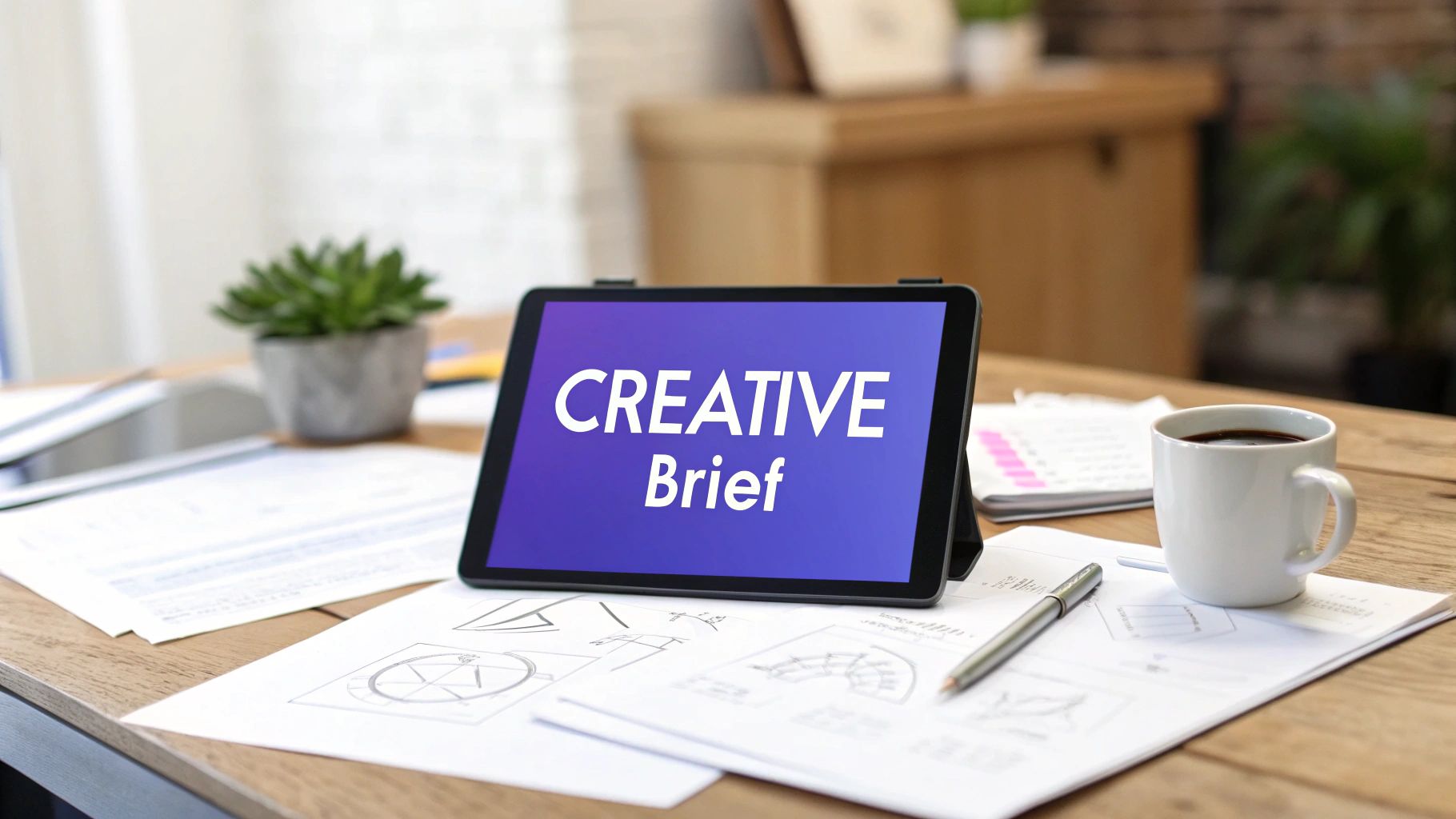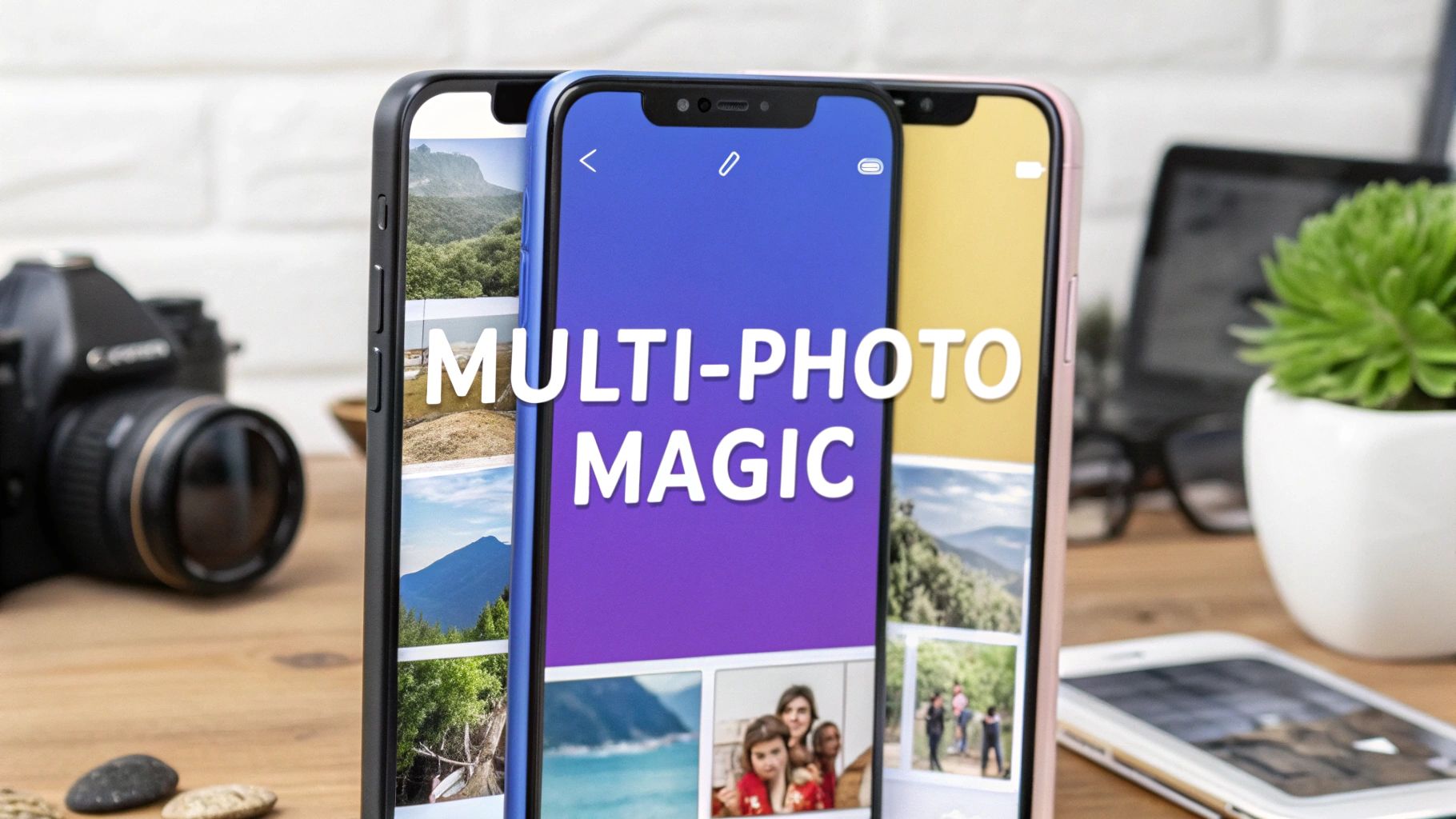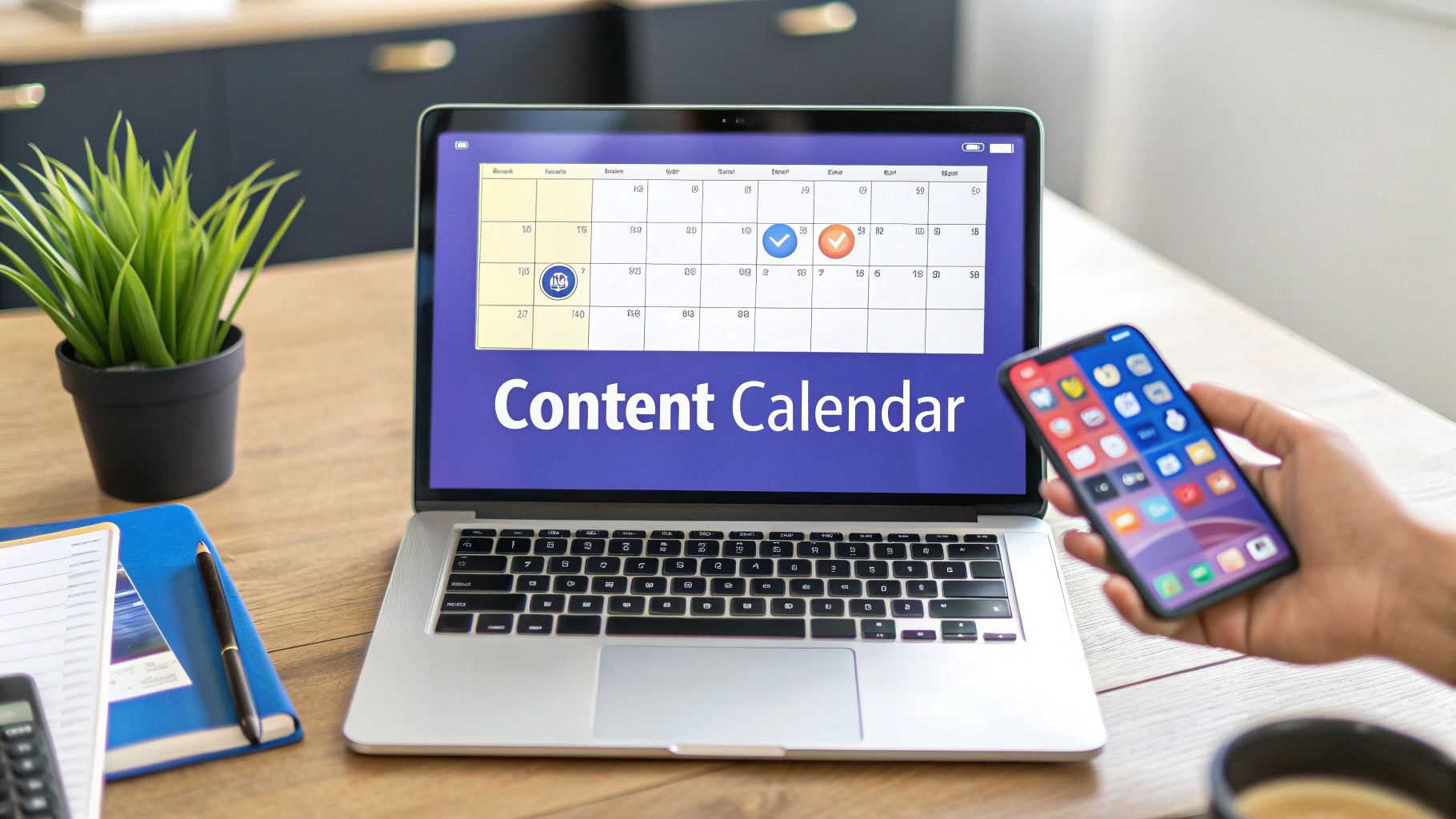Let's be real for a minute. Just "having a social media profile" isn't a strategy. It's the bare minimum. If you want to actually grow your brand awareness, you can't just show up—you have to stand out.
Success on social media today means weaving together compelling content, genuine community building, and unwavering consistency. It's about earning your spot as a memorable and trusted voice in your audience's daily scroll.
Why Social Media Is Your Greatest Brand-Building Tool
The days of posting passively and hoping for the best are long gone. Think of today's social media platforms as massive, bustling digital cities. To get noticed, your brand can't just be another face in the crowd; it needs to become a landmark. To truly grasp how to increase brand awareness, you have to appreciate the sheer scale of it all and the fundamental shift in how people behave online.
The Modern Social Media Environment
Let's face it: the attention economy is brutal. People aren't just scrolling anymore; they're actively looking for connection, entertainment, and real value. For brands that get this, it's a golden opportunity.
In 2025, global social media use is still climbing, with people spending over 14 billion hours on these platforms every single day. That's more than one full waking day per week for the average internet user. If that doesn't scream "opportunity," I don't know what does. You can dive deeper into these numbers with the latest social media statistics report.
To tap into this, you need a plan. It’s time to move beyond generic company updates and build a strategy that revolves around a few core ideas:
- Content That Connects: Create posts that actually help, entertain, or inspire your audience. Position your brand as a go-to resource, not just a seller.
- A Real Community: Foster actual conversations. Make your followers feel seen and heard. This is what turns passive scrollers into loyal fans.
- Unshakeable Consistency: Show up regularly. A consistent posting schedule, along with a cohesive brand voice and look, is what builds recognition and trust over time.
When a brand jumps into conversations, gives thoughtful replies, and celebrates its followers by sharing their content, something powerful happens. You transform passive observers into active advocates. This is the absolute cornerstone of building awareness that lasts.
Laying a Foundation for Visibility
Building a brand that people remember and trust doesn't happen by accident. It’s the direct result of a smart, multi-layered approach.
This guide is your roadmap. We’ll walk through everything from organic growth hacks and paid amplification to community-building tactics and tracking your analytics. And for those targeting specific markets, digging into a winning social media marketing guide for the UAE can provide some incredibly valuable, location-specific insights.
Before diving into the specific tactics, it's helpful to have a high-level view of the strategic pillars that support any successful brand awareness campaign.
Core Pillars of Social Media Brand Awareness
This table breaks down the essential components of a strong social media strategy. Think of it as your cheat sheet for building a memorable brand presence.
| Pillar | Objective | Key Tactics |
|---|---|---|
| Content Creation | Establish authority and provide value | Educational posts, behind-the-scenes looks, inspirational stories, entertaining videos |
| Community Engagement | Build relationships and foster loyalty | Responding to comments/DMs, hosting Q&As, sharing user-generated content (UGC) |
| Strategic Consistency | Create recognition and build trust | Regular posting schedule, cohesive visual branding, consistent tone of voice |
| Paid Amplification | Reach new, targeted audiences | Boosted posts, awareness ad campaigns, retargeting website visitors |
| Analytics &-nbsp;Reporting | Measure what works and optimize | Tracking reach/impressions, monitoring engagement rates, analyzing follower growth |
By focusing on these pillars, you can ensure your efforts are both strategic and sustainable.
By mastering the strategies we're about to cover, you can turn your social media presence from a simple broadcast channel into a powerful engine for brand growth. You won't just reach new audiences; you'll build meaningful relationships that drive loyalty for years to come.
Crafting a Content Strategy That Builds Recognition

Just throwing posts at the wall and hoping something sticks is a recipe for being ignored. A truly memorable brand is built on a deliberate content strategy—a real blueprint for recognition that defines not just what you share, but who you are.
A solid plan makes sure every single piece of content, from a quick tweet to a detailed tutorial, works together to reinforce your brand identity. It's the difference between shouting into the void and starting meaningful conversations that people actually remember.
This all starts with nailing down your brand's unique personality. Are you the witty, sarcastic friend like Wendy's, or are you more of an inspirational coach like Nike? That voice sets the tone for everything—your language, your humor, and how you engage with your followers. It needs to feel authentic to what your brand stands for and really connect with the people you’re trying to reach.
Establish Your Core Content Pillars
Instead of waking up and wondering, "What should I post today?", you need to establish three to five core content pillars. Think of these as the main topics or themes your brand will own and consistently discuss. They’re like the flagship shows on your brand's own TV network; everything you create should fit neatly into one of these categories.
This approach does more than just simplify your content creation. It also trains your audience on what to expect from you, building anticipation and loyalty.
For instance, a local fitness brand might build its strategy around these pillars:
- Workout Tutorials: Actionable videos and graphics that actually teach proper form.
- Nutritional Advice: Simple recipes, meal prep hacks, and myth-busting posts.
- Motivational Stories: Sharing real client transformations and inspiring quotes to keep the community fired up.
- Behind-the-Scenes: Introducing the trainers, showing the reality of gym life, and building a genuine human connection.
With pillars like these, every post has a clear purpose. You're providing balanced, valuable content that serves your audience, not just pushing a sale down their throats.
Develop a Consistent Visual Identity
People remember what they see. In a fast-scrolling, crowded feed, a strong visual identity makes your content instantly recognizable. This is about so much more than just slapping your logo on everything. It’s about creating a consistent look and feel with a defined set of brand elements.
A defined visual content strategy leaves a lasting impression. Consistent visuals—like logos, colors, typography, and design—make your brand more easily identifiable. This increases the likelihood that consumers will recall your brand when making purchase decisions.
Your visual toolkit should be crystal clear and include:
- Color Palette: A primary and secondary set of colors that show up in all your graphics and videos.
- Typography: Two to three consistent fonts for your headlines, body text, and any accents.
- Logo Usage: Simple, clear rules on how and where your logo should (and shouldn't) appear.
- Image Style: A specific filter, editing style, or photo composition that gives all your images a cohesive vibe.
This visual consistency isn't just about looking professional; it builds a powerful, unspoken connection with your brand. The goal is for someone to see your specific shade of blue or your signature font and immediately know it's you.
Brainstorm and Schedule Your Content
Once your pillars and visual identity are locked in, creating content becomes a much more organized process. The goal is to produce a steady stream of valuable posts without burning yourself out. To really move the needle on recognition, you'll need a mix of creative ideas, which is where looking into practical content creation tips can keep your strategy fresh and your workflow smooth.
Get your ideas organized with a content calendar. This doesn't have to be some fancy, expensive software—a simple spreadsheet often works best. Map out your posts at least a week or two in advance, making sure each piece ties back to one of your content pillars.
This simple act of planning lets you get ahead of holidays, product launches, or even relevant pop culture moments, ensuring your content is always timely and on-brand. A calendar turns your abstract strategy into a concrete, actionable plan—exactly what you need to build real, lasting brand awareness.
Driving Real Engagement for Organic Growth
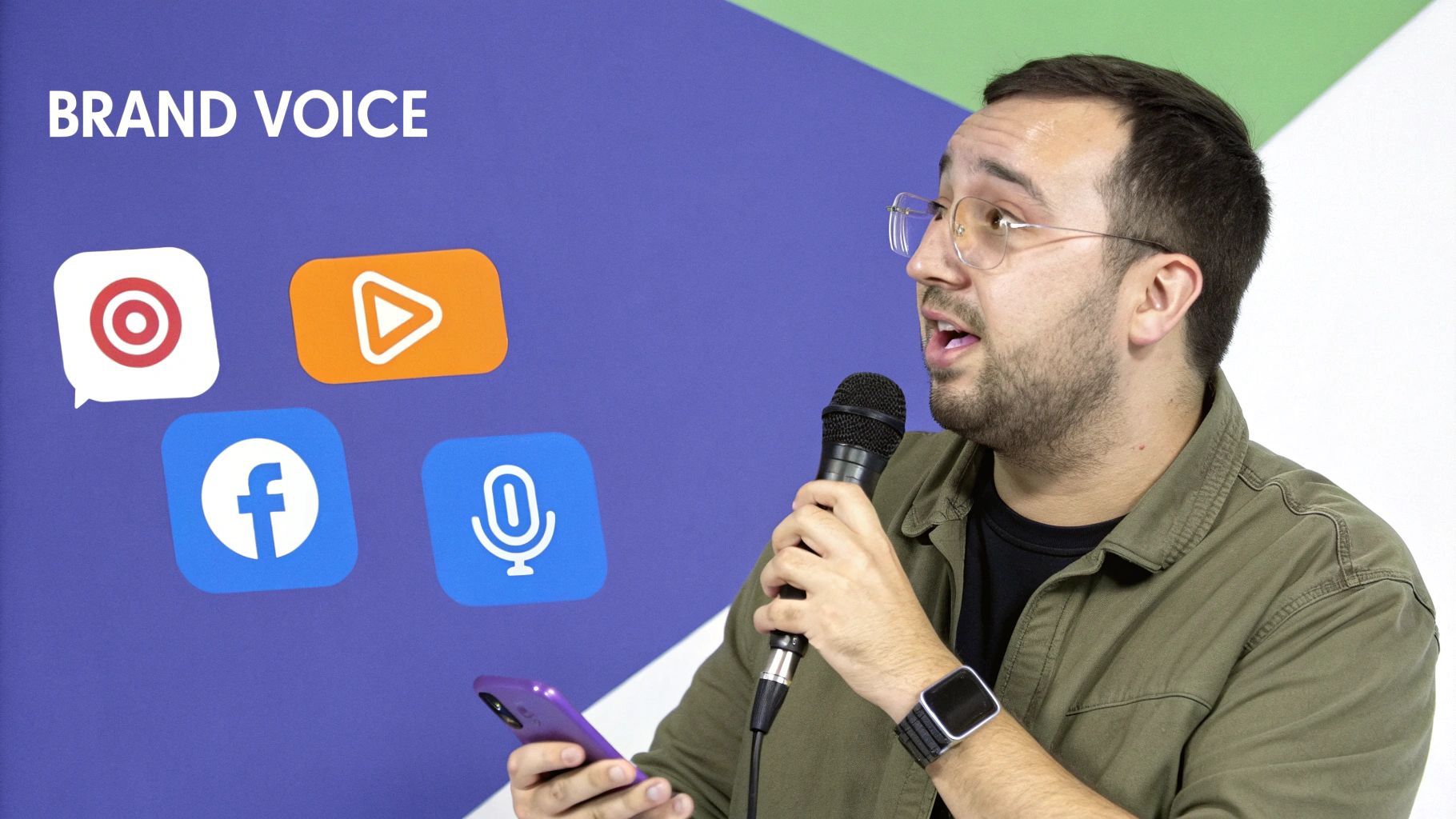
A killer content strategy is a great start, but true, organic growth really takes off when you build a brand people actually want to follow and interact with. This is where you stop just broadcasting your message and start building real connections that naturally expand your reach. It’s less about gaming algorithms and more about good old-fashioned human interaction.
The secret is to flip your mindset from "selling" to "serving" and "engaging." When your main goal is to add value to conversations and make your audience feel seen, visibility just becomes a natural result. This is how you build brand awareness that feels earned, not bought.
Get Serious About Short-Form Video
If you're still not creating short-form video, you're missing out on the single biggest opportunity for organic reach right now. Platforms like Instagram Reels and TikTok are literally built to push compelling, quick-hitting content to new audiences, making them a goldmine for awareness.
But don’t just chop up your old landscape videos and call it a day. Great short-form content is native to its platform. It’s all about stopping the scroll with a strong hook in the first 2 seconds, using trending audio in a smart way, and telling a fast, satisfying story. For a small business, this could be a 15-second "day in the life" clip, a quick tutorial solving a common headache, or even a clever take on a trending meme. The goal here is authenticity, not a high-production-value polish.
The numbers don't lie. Short-form video has completely taken over as the top format for boosting brand awareness. It’s staggering to think that 139 million Reels are watched every single minute around the world. And on TikTok, nearly half of all users have made a purchase because of something they saw on the platform. It's an absolute powerhouse.
Flip Your Influencer Marketing Strategy
Forget shelling out huge amounts of cash for a single, bland shoutout from a mega-influencer. The smarter, modern approach is all about building real, long-term partnerships with creators whose audiences are a perfect match for your brand. Think of it as a collaboration, not just a transaction.
Your focus should be on micro-influencers—those with follower counts typically between 10,000 and 100,000. These creators often have incredibly engaged, niche communities that genuinely trust their recommendations. An endorsement from them feels less like an ad and more like a friend sharing a great find.
Here’s how to build partnerships that actually work:
- Play the Long Game: Start by actually engaging with their content. Follow them, leave thoughtful comments, and show you appreciate their work before you ever pitch them.
- Offer More Than Money: Think about what you can provide that’s mutually beneficial. It could be free products, a unique experience you can offer, or even co-creating a content series that helps both of your audiences.
- Give Up Some Control: The best influencer content happens when you trust the creator to speak to their audience in their own voice. Give them a clear brief, but don't try to micromanage the creative side of things.
The most powerful drivers of awareness won’t come from your official brand channels; they'll come from your fans. Your community knows what their friends like. They become a direct pipeline to your most relevant future customers.
Become a Master of Community Management
That comment section on your posts? It’s not a chore; it's a goldmine. Active community management is one of the most underrated strategies for building loyalty and sparking organic growth. When people see a brand actively and thoughtfully jumping into conversations, it builds a massive amount of trust.
Go deeper than just "liking" comments. Ask follow-up questions, offer genuinely helpful advice, and tag other users when it makes sense. When someone shares a photo of your product, don’t just thank them—celebrate them! Ask for their permission to reshare it as user-generated content (UGC). UGC is incredibly powerful social proof that shows real people are out there loving your brand.
For a much deeper dive into turning followers into a thriving community, check out our guide on how to grow your social media following. A brand that listens and responds is a brand people want to be a part of. It’s as simple as that.
Using Paid Social Media to Amplify Your Reach
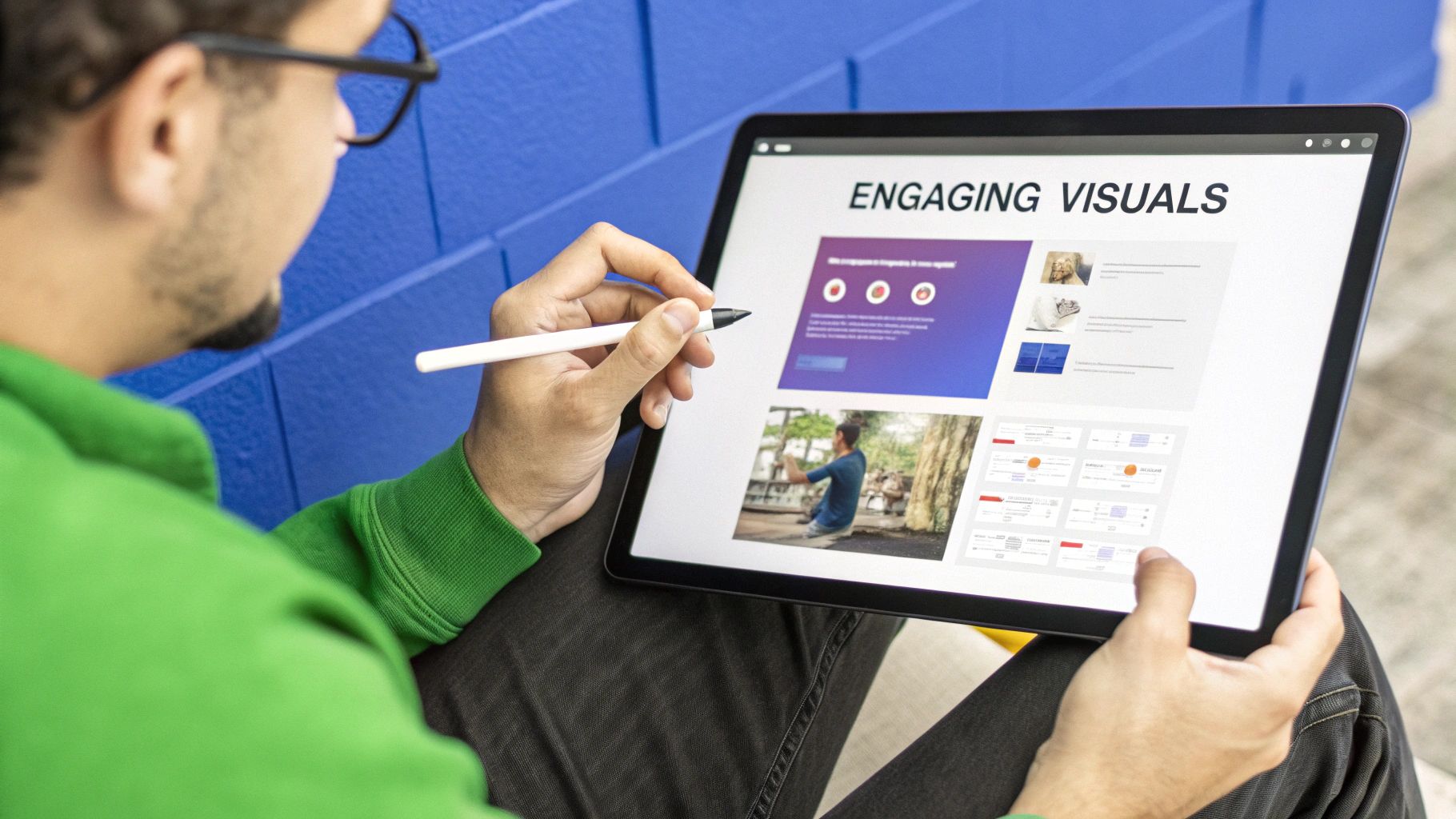 Organic growth is the bedrock of a solid social media presence, but let's be real—it has a natural ceiling. To truly break through and get your brand in front of thousands of new, relevant faces, you need to bring paid advertising into your toolkit. This is how you strategically turn up the volume on your message and fast-track your brand awareness goals.
Organic growth is the bedrock of a solid social media presence, but let's be real—it has a natural ceiling. To truly break through and get your brand in front of thousands of new, relevant faces, you need to bring paid advertising into your toolkit. This is how you strategically turn up the volume on your message and fast-track your brand awareness goals.
Think of paid social less as a replacement for your organic work and more as a powerful booster rocket. It lets you skip the slow, steady climb of organic reach and talk directly to the people most likely to become your next loyal followers and customers. Even a small, well-managed budget can deliver a huge bump in visibility if you know how to wield it.
Pinpointing Your Ideal Audience
The real magic of social media advertising is in its ridiculously specific targeting. Gone are the days of casting a wide, expensive net and just hoping for the best. Today, you can zero in on your ideal customer with incredible precision, making sure every dollar you spend is pulling its weight.
When you’re setting up that first awareness campaign, you have to go beyond the basics like age and location. The campaigns that really hit home are the ones that dig into the psychographics of a target market.
- Interest-Based Targeting: This is your bread and butter. You can reach people who've already shown interest in topics related to your industry. For a sustainable fashion brand, this could mean targeting users interested in "ethical fashion," "slow fashion," or even specific competitor brands.
- Behavioral Targeting: Get even more granular by targeting users based on their online actions, like recent purchase behavior or travel habits. An outdoor gear company, for instance, could target people who frequently engage with hiking content or have recently visited national park websites.
- Lookalike Audiences: This is easily one of the most powerful tools in your arsenal. You upload a list of your existing customers or engaged followers, and the platform goes out and finds new users with similar characteristics. It’s like cloning your best customers.
This kind of detailed targeting ensures your ads are seen by people who will genuinely find them relevant, which massively improves your chances of making an impression that sticks.
Creating Ad Content That Stops the Scroll
An ad is completely worthless if it doesn't stop someone from scrolling through their crowded feed. Your ad creative—the combination of visuals and copy—needs to be engineered to grab attention and deliver a clear message in just a few seconds.
For awareness, video is king. A short, punchy video ad with bold, easy-to-read captions can show off your brand's personality and value proposition way more effectively than a static image ever could. Eye-catching carousel ads are also a fantastic way to showcase multiple products or tell a quick story.
Remember, the main goal here is awareness, not an immediate sale. Your ad's call-to-action (CTA) should reflect that. Instead of a hard "Buy Now," try softer CTAs like "Learn More" or "Follow Us" to encourage discovery and connection first.
And don't be afraid to experiment. A/B testing is non-negotiable. Run two different versions of an ad at the same time—maybe a video versus an image, or two different headlines—to see what actually performs better. This data-driven approach takes the guesswork out of the equation and helps you refine your strategy over time.
Understanding Your Budget and Key Metrics
You don't need a Fortune 500 budget to make an impact. The key is to start small, measure everything, and then scale up what’s working. When your main objective is to boost brand awareness on social media, you’ll be focused on two primary metrics.
- Cost Per Mille (CPM): This is simply the cost to show your ad to 1,000 people. A low CPM means you're getting your message out to a large audience efficiently.
- Frequency: This tracks the average number of times someone in your target audience has seen your ad. A frequency between 2-4 is often the sweet spot for building name recognition without annoying people.
The sheer amount of money being poured into social advertising tells you everything you need to know. Projections show that social media ad spending is set to hit a staggering $276.7 billion in 2025, with video being a major driver of that growth. As organic reach gets tougher, a smart paid strategy isn't a "nice to have" anymore—it's essential for any brand that wants to be seen.
To get a handle on your paid efforts, it's worth exploring tools built to optimize campaign management. For instance, services like Adfuel Plus can help you manage and scale your campaigns much more effectively. By combining smart targeting, compelling creative, and careful measurement, you can use paid social to dramatically expand your brand’s footprint.
Tailoring Your Strategy for Key Social Platforms
Let's get one thing straight: posting the exact same content across every social platform is a surefire way to get ignored. I’ve seen it happen time and time again. A ‘one-size-fits-all’ strategy just doesn't fly because each network has its own vibe, its own audience expectations, and its own content sweet spots.
To genuinely grow your brand awareness, you have to speak the native language of each platform. This is about more than just avoiding lazy cross-posting. It's about understanding the unique ecosystem where your audience lives and making your content feel like it belongs there, not like a random ad that just got dropped in.
Instagram: Visual Storytelling and Connection
Instagram is, and always has been, a visual-first world. You build awareness here with stunning images and, more importantly, authentic video. Forget the boring, static product shots. Your focus should be on telling stories through high-impact Reels and getting your audience involved with interactive Stories.
For instance, a skincare brand could kill it with a "get ready with me" Reel. Using trending audio and quick, snappy cuts makes it feel native to the feed. Then, they could follow up with an Instagram Story poll asking followers which skin issue they should tackle next, creating an instant feedback loop and making people feel heard.
The brands that truly win on Instagram don't just post pretty pictures. They use the platform's entire toolkit—Reels, Stories, Guides, and Carousels—to build a rich brand experience that educates, entertains, and connects on a human level.
LinkedIn: Professional Authority and Thought Leadership
Over on LinkedIn, the game completely changes. We're not talking about lifestyle content anymore; it’s all about professional value. This is your stage for establishing your brand as a credible, go-to authority in your industry. The hard sell is a major turn-off here. The real currency is expertise, sharp insights, and genuinely helpful advice.
Share original data from a recent study, offer a thoughtful take on a new industry trend, or break down a detailed case study that shows off your results. A B2B software company could create a simple carousel post that unpacks a complex industry problem into five easy-to-digest steps. The goal is to contribute to the professional conversation, not just shout your marketing messages into the void.
TikTok: Authenticity and Tapping into Trends
TikTok is a different beast entirely. It rewards authenticity and raw creativity above all else. That slick, polished corporate video you spent a fortune on? It will almost certainly fall flat here. To build awareness on TikTok, your brand needs to act less like a corporation and more like a creator.
That means jumping on trends, using popular sounds, and making content that feels unpolished and user-centric. You have to show, not just tell. Instead of a video about how durable your product is, a brand could team up with a creator to put it through a real-world stress test. Success on TikTok is all about joining the party and serving up entertainment or value that feels right at home on the platform's fast-paced feed.
Facebook: Community Building and Groups
While its organic reach isn't what it used to be, Facebook is still an absolute powerhouse for building dedicated, tight-knit communities. One of the best, and often overlooked, ways to build awareness is by creating or engaging in Facebook Groups that revolve around your niche. This is where you can have direct, meaningful conversations with a super-engaged audience.
Imagine a pet food brand running a group for new puppy owners. They could share training tips, answer panicked questions at 2 AM, and just foster a supportive, helpful space. This kind of strategy positions the brand as a trusted guide, building deep loyalty and word-of-mouth awareness that goes way beyond the group itself.
X (Formerly Twitter): Real-Time Engagement
X is all about what’s happening right now. It’s fast, it’s chaotic, and it’s the pulse of the internet. Building awareness here means being nimble. You have to be ready to jump into trending conversations and show off your brand's personality with witty, timely commentary.
Using hashtags strategically is your key to getting seen by a much wider audience. This infographic breaks down the difference between using your own branded hashtags versus tapping into what's already trending.
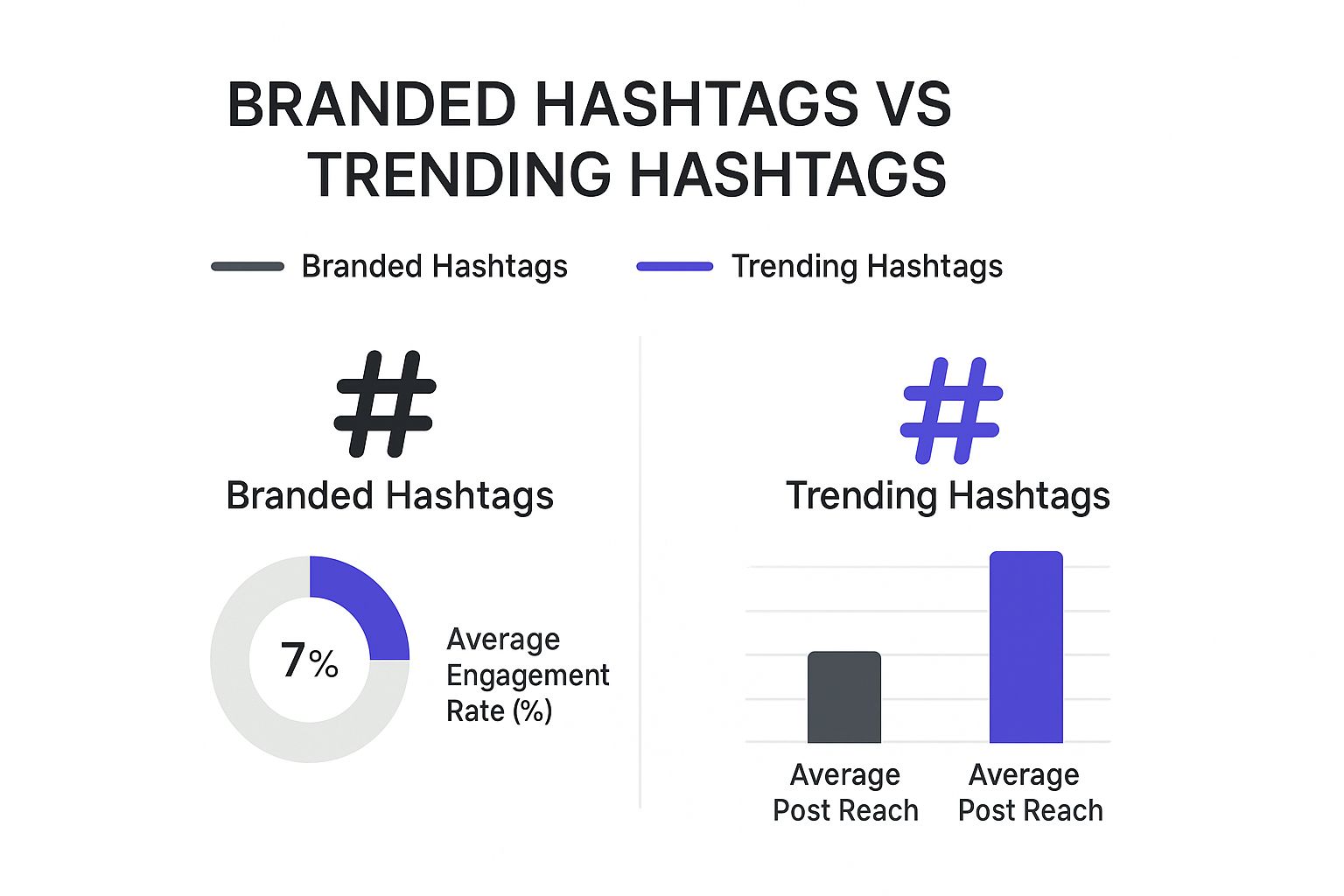
The data makes it pretty clear: while your branded hashtags are essential for tracking campaigns, jumping on trending topics is how you find explosive new reach. A solid plan needs a mix of both. To keep all these moving parts from becoming overwhelming, a good social media marketing plan template can be a lifesaver, helping you organize your unique strategies for each platform into one clear roadmap.
Platform Strategy Comparison for Brand Awareness
To make it even clearer, let's break down how to approach each platform for brand awareness. Think of this as your cheat sheet for choosing the right content for the right network.
| Platform | Primary Audience | Best Content Format for Awareness | Key Strategy |
|---|---|---|---|
| Millennials & Gen Z | Reels, Stories, High-Quality Carousels | Visual storytelling, influencer collaborations, and community engagement through interactive features. | |
| Professionals, B2B Decision-Makers | Articles, Text Posts, Carousels, Short Videos | Establish thought leadership, share industry insights, and network with professional content. | |
| TikTok | Gen Z & Younger Millennials | Short-Form Vertical Videos | Participate in trends, use humor and authenticity, and partner with creators for user-generated feel. |
| Gen X & Millennials | Videos, Community Posts, Facebook Groups | Build community, run targeted ads, and share valuable content within niche groups. | |
| X (Twitter) | Broad; News-focused Users | Short Text Posts (Threads), Memes, GIFs, Polls | Engage in real-time conversations, share timely news/commentary, and showcase brand personality. |
Ultimately, picking the right platforms and tailoring your content is what separates brands that get noticed from those that get lost in the noise. By respecting the culture of each network, you build a much stronger, more authentic connection with your audience.
Measuring What Matters and Optimizing Your Efforts
All that hard work creating great content and building a community is fantastic, but it's only half the story. How can you be sure your efforts to boost brand awareness are actually moving the needle? The answer isn't in guesswork; it's hiding in plain sight within your data.
It’s time to stop chasing vanity metrics and start focusing on the key performance indicators (KPIs) that truly define awareness. Let's get real about what you should be tracking.
Key Metrics for Brand Awareness
These four metrics paint a surprisingly clear picture of your brand's visibility and how people perceive you. Knowing the difference between them is the first step toward smart optimization.
- Reach: This is the total number of unique people who laid eyes on your content. Think of it as the breadth of your audience—how wide are you casting your net?
- Impressions: This is the total number of times your content was shown to people. High impressions can mean your message is getting reinforced, as the same users might see it multiple times.
- Share of Voice: This metric is all about context. It stacks your brand’s mentions up against your competitors'. It directly answers the question, "How much of the conversation in our industry do we actually own?"
- Social Sentiment: This goes a layer deeper than just counting mentions. It tracks the feeling behind the chatter. Are people talking about your brand positively, negatively, or just neutrally?
You can track these using the tools built right into the platforms, like Instagram Insights, or get more firepower from a dedicated third-party tool. The key is consistency—this gives you a real-time pulse on your performance.
When you can see which content drives the highest reach and the most positive sentiment, you're no longer just creating content—you're strategically engineering brand recognition. This data is your roadmap for what to create next.
Creating an Optimization Loop
Your analytics should be the fuel for a constant cycle of review and refinement. You have to make time for it. Block out a couple of hours each month to dive into your data and ask some tough questions.
Which content formats got the most shares? What topics actually sparked a conversation? What time of day did your posts pop off?
The answers give you incredibly clear, actionable insights. For instance, you might find your audience is glued to their phones on weekday mornings. Just knowing that can completely change your results. For a much deeper dive, learning about the best times to post on social media will help you squeeze every last drop of visibility out of your schedule.
This rinse-and-repeat process of measuring, learning, and tweaking is what separates the brands that feel stuck from those that experience nonstop growth. When you embrace this data-first mindset, you guarantee your strategy evolves, your content connects, and your brand awareness is always climbing.
Your Top Brand Awareness Questions, Answered
Growing brand awareness on social media always brings up a few common questions. Let's tackle some of the things that marketers and founders ask me most often when they're trying to get their name out there.
How Long Does It Take to See Results?
This is the million-dollar question, isn't it? Truthfully, there’s no magic number. Your timeline is going to hinge on your niche, how consistent you are, and your budget.
If you're going the purely organic route—posting great content and engaging with your community every single day—you'll likely start to see some real movement in followers and interaction within 3 to 6 months.
Paid ads, on the other hand, can slash that time significantly. They give you immediate reach, putting your brand in front of thousands of potential followers almost overnight. But building genuine, lasting brand recall is a marathon, not a sprint. The real key is consistent, steady effort, not just a flash in the pan.
What Is the Difference Between Reach and Impressions?
It’s so easy to get these two mixed up, but they tell you very different stories about your performance.
- Reach tells you the total number of unique people who saw your content. If 100 different individuals view your post, your reach is 100. Simple as that.
- Impressions count the total number of times your content was displayed. If just one of those 100 people sees your post three separate times, that adds 1 to your reach but 3 to your impressions.
When you're focused on awareness, reach shows you how wide your net is being cast. A high impression count, however, suggests your message is really sticking and getting reinforced with your audience.
Think of it this way: Reach is about how many people you introduce your brand to, while impressions are about how many times you remind them you exist. Both are crucial for building recognition.
How Can a Small Business Compete with a Limited Budget?
Let's be real: as a small business, you can't outspend the big corporations. So, you have to out-smart and out-connect them. Your greatest advantage is your authenticity and your ability to build a tight-knit community.
Forget about broad, expensive ad campaigns. Instead, pour your energy into creating high-value, niche content that speaks directly to a very specific audience's problems and passions.
Become a master of community management. Make it a point to thoughtfully respond to every single comment. Actively look for and celebrate user-generated content—this turns your customers into your most powerful marketers. You can also team up with micro-influencers whose followers might be smaller in number but are often way more engaged. Your secret weapon is building those personal connections that big brands just can't replicate at scale.
Ready to stop guessing and start growing? PostSyncer provides all the tools you need—from AI-powered scheduling to in-depth analytics—to manage your social media and build brand awareness efficiently. Start your free 7-day trial and see the difference.
